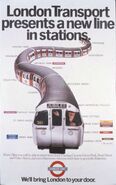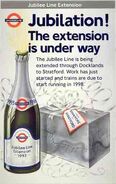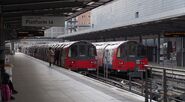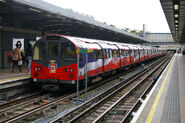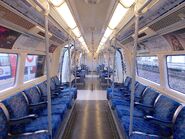London Underground Jubilee Line is a Transport for London operated tube line in London, England. Running between Stanmore in the suburban north-west and Straford in east London via the Docklands, South Bank and West End, it is coloured silver on the Tube map, to mark the Silver Jubilee of Elizabeth II, after which the line was named.
Between Finchley Road and Wembley Park the Jubilee line shares its route with the Metropolitan line and Chiltern Main Line. Between Canning Town and Stratford it runs parallel to the Stratford International branch of the Docklands Light Railway.
History[]
The western portion beyond Baker Street was previously a branch of the Bakerloo line, while the new build was completed in two major sections: initially in 1979 to Charing Cross, then in 1999 with an extension to Stratford. The later stations are larger and have special safety features, both aspects being attempts to future-proof the line. Following the extension to east London, serving areas once poorly connected to the Underground, the line has seen a huge growth in passenger numbers and is the third-busiest on the network, with over 213 million passenger journeys in 2011/12.
At first, the Metropolitan had advocated a new underground line roughly following the line of the Edgware Road between the tube station and a point near Willesden Green. Indeed, construction advanced as far as the rebuilding of Edgware Road station to accommodate 4 platforms of 8-car length. Things changed, though, with the formation of the London Passenger Transport Board (LPTB) and the subsequent absorption of the Metropolitan. The solution was now a new branch of the Bakerloo line from Baker Street to serve new stations at St. John's Wood and Swiss Cottage, thereby rendering the existing stations of Lord's, Marlborough Road and Swiss Cottage on the parallel route redundant, and negating the need for the Met's extension from Edgware Road station. It was originally proposed that Swiss Cottage (Metropolitan) would remain open during peak hours for interchange with the Bakerloo, and that Lord's station would open for special cricketing events, but both were closed permanently as economy measures during the Second World War. The new line rose between the Metropolitan tracks at Finchley Road, providing cross-platform interchange with the Metropolitan line. Continuing north to Wembley Park, the new Bakerloo was to provide intermediate service on the Metropolitan line, allowing Metropolitan line trains to run non-stop between Finchley Road and Wembley Park, cutting seven minutes from journey times. At Wembley Park, the new Bakerloo would run on to serve Kingsbury, Queensbury, Canons Park and Stanmore, taking over the former Metropolitan branch. The Bakerloo extension, built as above, opened in 1939.
The planning for the Tube network immediately before and after World War II considered several new routes. The main results of this study concerned two major routes: the south-to-northeast "line C", and lines 3 and 4, new cross-town routes, linking the northeast suburbs to Fenchurch Street, Wapping and variously Lewisham and Hayes. Line C opened as the Victoria line, in stages, from 1968 to 1972. Work on the northeast–southwest route continued.
The "Fleet line" was mentioned in a 1965 Times article, discussing options after the Victoria line had been completed — suggesting that the Fleet line could take a route via Baker Street, Bond Street, Trafalgar Square, Strand, Fleet Street, Ludgate Circus and Cannon Street, then proceeding into southeast London.
In 1971, construction began on the new Fleet line. Economic pressure and doubt over the final destination of the line had led to a staged approach. Under the first stage, the Baker Street-to-Stanmore branch of the Bakerloo line was joined at Baker Street to a new 2.5-mile (4 km) segment into central London, with intermediate stops at Bond Street and Green Park and terminating at a new station at Charing Cross, thereby relieving pressure on the West End section of the Bakerloo line between Baker Street and Charing Cross and also allowing increased frequencies on the section north of Baker Street. The new tube was to offer cross-platform interchange between the Bakerloo and Fleet at Baker Street, as pioneered on the Victoria line. The work was completed in 1979. As part of the works, Trafalgar Square (Bakerloo) and Strand (Northern) stations were combined into a single station complex, Charing Cross. The existing Charing Cross station on the sub-surface District and Circle lines was renamed Embankment.
Changes in land use, particularly the urban renewal of the Docklands area, resulted in the project to extend the line beyond Charing Cross being changed considerably in the 1970s, 1980s and 1990s. The Jubilee Line Extension, as the eventual project became known, opened in three stages in 1999. It split from the existing line at Green Park, creating a one-station branch to Charing Cross which is now closed (though still maintained for reversing trains at times of disruption, and for occasional use as a film set). The line extends as far as Stratford, with ten intermediate stations. This section is unique on the London Underground because it is the only section to have special platform edge doors which open automatically when trains arrive.
When the Jubilee line was opened, it was operated by 1972 stock. In 1984 this was partially replaced by the new 1983 stock: the displaced 1972 stock was transferred to the Bakerloo line. The 1983 stock proved to be unreliable and troublesome in service, with single-leaf doors making passenger loading and unloading a slower process than on other stock with wider door openings. With the construction of the Jubilee line Extension, the opportunity was taken to introduce new trains, and today the line is worked by 1996 stock, which has an exterior similar to the 1995 stock in use on the Northern line but (in spite of the confusing naming) is technically less advanced. The new stock has internal displays and automated announcements to provide passengers with information on the train's route. At first the displayed text was static and showed only the destination of the train, but later showed also the name of the next station and interchanges there. Subsequent modifications introduced scrolling text. The 1996 stock uses a different motor from the 1995 stock and has a motor design similar to Class 465 and Class 466 Networker trains.
Current Route[]
The Jubilee Line operates via these primary locations.
- Stanmore
- Canons Park
- Queensbury
- Kingsbury
- Wembley Park
- Neasden
- Dollis Hill
- Wilesden Green
- Kilburn
- West Hampstead
- Finchley Road
- Swiss Cottage
- St. John's Wood
- Baker Street
- Bond Street
- Green Park
- Westminster
- Waterloo
- Southwark
- London Bridge
- Bermondsey
- Canada Water
- Canary Wharf
- North Greenwich
- Canning Town
- West Ham
- Stratford


